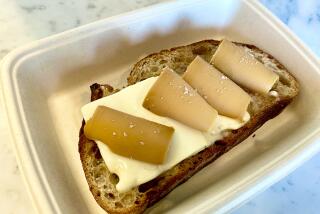A Fading Morning Glory
- Share via
The American breakfast is getting more healthful, but fewer Americans are bothering to eat it.
A study conducted by researchers at the University of North Carolina at Chapel Hill shows that the classic American breakfast of bacon, eggs, whole milk, white toast and butter is becoming rare. Taking its place is a breakfast of whole-grain breads and high-fiber ready-to-eat cereals.
But the same study showed that 25% of adults don’t eat breakfast at all, compared with 14% in 1961.
“That [old-fashioned] breakfast requires preparation,” says Doris Derelian, a nutritionist and spokeswoman for the American Dietetic Assn. “The 1990s family has so much activity that has to be crammed into a day that something has to be given up. So breakfast-eating is sacrificed.”
The decline in breakfast-eating comes in the face of mounting evidence showing the benefits of a morning meal. Studies reveal that school attendance and classroom performance improve when children eat breakfast. And nutritionists say that adults perform better, eat more healthful meals later in the day and stay on their diets when they eat breakfast.
“If you don’t eat, you’re going to feel tired, slow and sluggish,” says Derelian, “and you’re going to feel incredibly hungry. In adults, you’re going to get headaches, irritability and maybe some trembling. In kids, it absolutely interferes with their learning.”
A study conducted by Ernesto Pollitt of UC Davis took 9- to 11-year-old children and gave half of them a 535-calorie breakfast of waffles, syrup, margarine, orange juice and milk at 7 a.m. The other half got a noncaloric drink with no caffeine. At 11:30 a.m., the children were given a series of tests. After a week, the group that was given breakfast was given the drink, and vice versa.
Pollitt found that children who got breakfast committed fewer errors. He conducted a similar test, giving children a breakfast of milk, cereal with sugar, egg, juice and toast, and found that the ones who ate the breakfast had fewer arithmetic errors in tests.
“Give it to them,” Pollitt said in a phone interview when asked about breakfast. Although his studies show improvements only in specific tasks performed by specific groups of children, he said the body of evidence is clear. “If the child has breakfast, you will be sure that the probabilities of operating at a higher level will be greater, no doubt about it.”
However, it’s younger people who are increasingly turning their backs on breakfast. Today, 12% of schoolchildren do not eat any meal until lunch, according to the American Dietetic Assn.
The effect of breakfast on adult performance has been more difficult to measure, says Derelian, a past president of the dietetic association. Adults don’t take standardized tests or perform comparable tasks.
“As an adult, the evidence is not clear,” Derelian says. She admits that some adults can “habituate themselves to not having breakfast,” but she still advocates a morning meal, especially for women, who routinely give up breakfast in the name of weight loss.
“American women believe that skipping breakfast is a weight-control behavior,” she says. “Obviously, if the adult woman in the household does that, the children, particularly the young girls, are going to do the same thing.”
Pamela Haines, co-author of the Chapel Hill study on adult breakfast patterns, is a specialist on diets of women from young to old. “Skipping breakfast is very clearly a weight-control mechanism among young women,” she says. “For them, anything to do with gaining weight is abhorrent.”
The growing trend toward younger women’s dieting may be the reason so many are skipping breakfast, she says.
“Bad idea,” says Sheah Rarback, a nutritionist and spokeswoman for the dietetic association. “Just because you want to lose weight doesn’t mean you want to lose nutrition.”
High-fiber cereal with skim milk is a good way to get nutrients and is low in calories, Rarback says.
“Eating breakfast does not sabotage a weight-loss plan,” she adds. “In fact, it’s just the opposite. When you’re hungry, you make poor food choices. By having breakfast, you’re not going to give in to that 10 a.m. temptation of eating whatever is around.”
WAKE-UP SHAKE
1 cup vanilla fat-free yogurt
1/2 cup frozen berries (like raspberries or blueberries)
1/4 cup orange juice
1 medium banana, cut into chunks
From “Betty Crocker’s New Eat & Lose Weight” (Macmillan, 1997).
Place yogurt, berries, juice and banana in blender. Cover and blend on high speed until smooth, about 30 seconds. Serve immediately.
2 servings. Each serving:
181 calories; 81 mg sodium; 2 mg cholesterol; 1 gram fat; 39 grams carbohydrates; 8 grams protein; 1.70 grams fiber.
*
APPLE RAISIN OATMEAL
2 1/2 cups apple cider or apple juice
1/4 cup raisins
1 apple, peeled, cored and diced
3/4 teaspoon cinnamon
1 1/2 cups rolled oats
1/2 cup nonfat plain yogurt
1 teaspoon ground nutmeg
From “Jane Fonda Cooking for Healthy Living” (Turner Publishing, 1996).
Bring cider to boil in medium saucepan over medium-high heat. Stir in raisins, apple and cinnamon, reduce heat to low and simmer 2 minutes.
Stir in oats, increase heat to medium-high and bring to boil. Reduce heat to low and simmer, stirring frequently, until liquid is absorbed and oats are creamy, about 6 minutes.
To serve, divide among 4 individual bowls. Top each with equal amount of yogurt and nutmeg.
4 servings. Each serving:
252 calories; 27 mg sodium; 0 cholesterol; 2 grams fat; 53 grams carbohydrates; 7 grams protein; 0.96 gram fiber.
*
ALPINE MUESLI
1/2 cup quick-cooking oats
1 cup skim milk
1/2 cup plain nonfat yogurt
1 cup orange juice
1/3 cup ground hazelnuts
1/4 cup fructose (or honey)
1 pound (about 1 1/2) apples
1 pound finely chopped mixed fresh fruit (about 1 peach, 3 apricots, and 1/4 honeydew melon)
From “Great Tastes: Healthy Cooking From Canyon Ranch” (Canyon Ranch, 1995).
Combine oats, skim milk and yogurt in large bowl and let sit for 5 minutes to soften oats.
Add orange juice, hazelnuts and fructose to oat mixture. Stir thoroughly.
Grate apples and immediately stir into mixture to prevent apples from turning brown. Stir in chopped fruit. Serve chilled.
8 servings. Each serving:
160 calories; 28 mg sodium; 3 mg cholesterol; 5 grams fat; 28 grams carbohydrates; 4 grams protein; 0.57 gram fiber.






